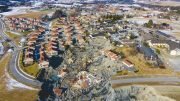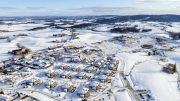The Norwegian Water Resources and Energy Directorate (NVE) has inspected Romerike and identified 98 quick clay zones that they plan to investigate more thoroughly this autumn.
In the autumn of 2021, the NVE carried out a survey to check the condition along rivers, streams, and ravines in selected quick clay zones in the municipalities of Ullensaker, Gjerdrum, and Nannestad.
The 98 quick clay zones selected are based on the collection of basic data and terrain data, erosion inspections, and initial ground investigations. Out of the total, 22 zones are located in Gjerdrum, 40 in Nannestad, and the remaining 36 in Ullensaker.
“If there is erosion in these quick clay zones and the ground conditions are unfavorable, there is at risk for landslides. This is what we like to find out and create the basis for safety precautions if necessary,” project manager Ingrid Havnen at the NVE told Norway Today via e-mail.
The work was carried out after the quick clay landslide in Gjerdrum that took place on December 30, 2020. There is quick clay in large parts of Øvre Romerike.
Risk status of the quick clay zones
“The hazard is an expression of the probability of a landslide, and it is evaluated by the topographical, geotechnical, and hydrological conditions and changes due to human activities, climate effects, erosion, etc.
“The consequence is based on population, settlement, infrastructure, and other factors. The risk is the product of hazard and consequence. Each of these factors is given a score and is weighted according to its importance in causing a landslide or according to the consequences a landslide would have for the hazard,” Havnen explained.
She stated that the hazard is divided into three classes; “high hazard,” “middle hazard,” and “low hazard.” The consequences of the hazard are also divided into three classes: “not severe,” “severe,” or “highly severe,” and the risk is divided into five classes.
The report will likely be finalized at the end of 2023, according to Havnen.
Robin-Ivan Capar is a contributor and editor at Norway Today.
Source: #Norway Today / #NorwayTodayNews
Do you have a news tip for Norway Today? We want to hear it. Get in touch at [email protected]




Be the first to comment on "Almost 100 quick clay zones in Romerike will be investigated by the NVE to assess risk"